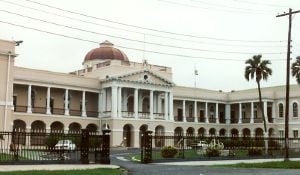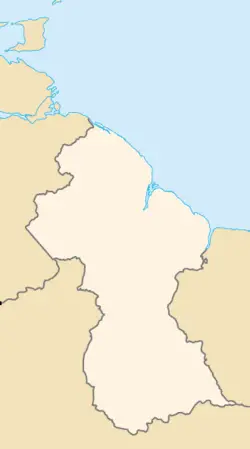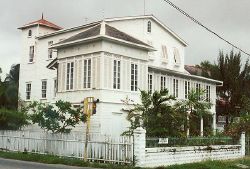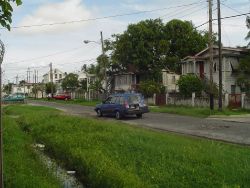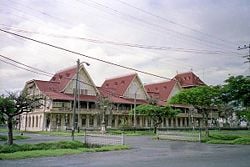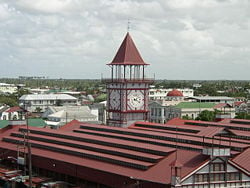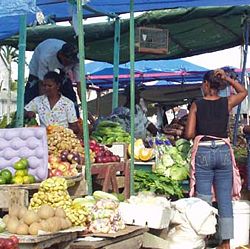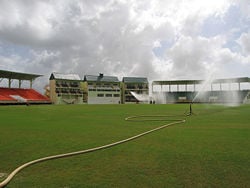Georgetown, Guyana
| Georgetown, Guyana | |
| Parliament Building, Georgetown | |
| Nickname: Garden city | |
| Location in Guyana | |
| Coordinates: 6°48′N 58°10′W | |
|---|---|
| Country | |
| Admin. division | Demerara-Mahaica |
| Population (2002) | |
| - Total | 310,320 |
Georgetown is the capital and largest city of Guyana, located in the Demerara-Mahaica region. The city serves as a retail and administrative centre, as well as a financial services centre.
Geography
Georgetown was named after King George III when the city was founded by the British in 1781. It is situated on the Atlantic Ocean coast at the mouth of the Demerara River and it was nicknamed "Garden City of the Caribbean".
The local climate is tropical, hot and humid, moderated by northeast trade winds. The average maximum daytime temperature year-round is 86°F (30°C). Mean annual precipitation is 40 inches (1004mm).
Georgetown, which is laid out in a north-south, east-west grid, is interlaced with canals protected by kokers, or sluices, built by the Dutch and later the British that provide drainage to a city that lies three feet (one meter) below high-tide level. A long sea wall helps prevent flooding.
Georgetown has expanded dramatically through the years and may be divided into three Geographical regions: Central Georgetown that includes the business district as well as the seat of the federal Government; Greater Georgetown, that contains some of the most expensive and luxurious metropolitan neighbourhoods; and South Georgetown, along the eastern bank of the Demerara River, which is a poor area.
The city has an abundance of tree-lined streets and avenues and contains many wooden colonial buildings and markets. Regent St is Georgetown's premier shopping district, while Sheriff St is Guyana's main entertainment hot spot.
History
Georgetown gained official city status on August 24, 1842, during the reign of Queen Victoria.
The history of Guyana began before the arrival of Europeans, when the region of present-day Guyana was inhabited by Carib, Arawak, and Warao peoples. Guyana's first sighting by Europeans was by Alonzo de Ojeda and Amerigo Vespucci in 1499. In 1595 the area was explored by English explorers under Sir Walter Raleigh. The Dutch began exploring and settling in Guyana in the late sixteenth century, followed by the British. Both began trading with the Amerindian peoples upriver.
The first Dutch settlement was established on the Pomeroon River in 1581. The settlers were evicted by Spaniards and Indians, probably in 1596. Until 1804 there were estates, now forgotten, Sandy Point and Kierfield, on the seaward side of the present seawall of Georgetown.
The city of Georgetown began as a small town in the 18th century. Originally, the capital of the Demerara-Essequibo colony was located on Borselen Island in the Demerara River under the administration of the Dutch. When the colony was captured by the British in 1781, Lieutenant-Colonel Robert Kingston chose the mouth of the Demerara River for the establishment of a town which was situated between Plantations Werk-en-rust and Vlissengen.
The French developed this town and made it their capital city when they captured the colony in 1782. The French called the capital La Nouvelle Ville. They established stringent regulations for private building in an attempt to guard against the dangers of flood and fire. Buildings were to have brick foundations, kitchens were to be tiled and set apart, and no thatch was to be used. Brickdam, the first paved road, was built by the French, and was known then as Middle Dam.
When the town was taken by the Dutch in 1784, it was renamed Stabroek after Nicolaas Geelvinck (1732 — 1787), Lord of Stabroek, and President of the Dutch West India Company. Eventually the town expanded and covered the estates of Vlissengen, La Bourgade and Eve Leary to the North, and Werk-en-rust and La Repentir to the South.
When the British regained control in 1812, it was renamed Georgetown, in honour of King George III, with the proviso that the various districts of Georgetown shall be known by their own names, and that the supervision of Georgetown was to be done by a committee chosen by the Governor and Court of Policy.
The names of Georgetown's wards and streets reflect the influence of the Dutch, French and English who administered the town at different periods of history.
Cummingsburg was named after its second proprietor, Thomas Cuming, a Scotsman, who laid out the area in streets and building lots. Water St ran along the riverside and formed the original river dam. High St formed the leading road from the East Bank to the East Coast of Demerara.
Camp St was the road which led to the camp or garrison at the northern end of the city. Kingston got its name from King George of England.
Bourda St and the ward of Bourda were named after Joseph Bourda, Member of the Court of Policy and former owner of Plantation Vlissengen. After Bourda's death, and since Bourda's son and heir had disappeared at sea, the government claimed the land.
Alberttown, which was part of what was formerly called Plantation Thomas, was laid out in 1847, and named after Prince Albert, husband of Queen Victoria of England.
In 1945 a large fire (The Great Fire) broke out in the city causing widespread damage.
By the late 20th century the city of Georgetown had expanded to include the village of Lodge, Alexander Village, East, West, North and South Ruimveldt, Roxanne Burnham Gardens, Kitty, Campbellville, Subryanville, Bel Air, Prashad Nagar, and Lamaha Gardens. The city extended from Cummings Lodge on the East Coast of Demerara to Agricola on the East Bank of Demerara.
Some street names were changed after Guyana gained independence. Murray Street was changed to Quamina Street in honour of the respected slave deacon whose son, Jack Gladstone, led the 1823 slave rebellion. Kelly's Dam was extended and renamed Carifesta Avenue to commemorate the Caribbean Festival of Arts which was held in Guyana in 1972. The part of Vlissengen Road extending from the Seawall to Lamaha Street was renamed J.B. Singh Drive. Part of High Street was renamed Avenue of the Republic when Guyana became a Republic.
More recently another section of High Street was renamed the Cheddi B. Jagan Drive in honour of the late president. Part of D'Urban Street was renamed Joseph Pollydore Street after the popular trade unionist. New roads were created such as Mandela Avenue, Homestretch Avenue, and Aubrey Barker Road. Mandela Avenue was named after the indomitable freedom fighter, Nelson Mandela, the former President of South Africa. Homestretch Avenue was so named because it was built on the former horse-racing ground at D'Urban Park in front of the pavilion which now houses the Ministry of Housing.
Government
Guyana is a republic in which the chief of state president is elected as leader of a party list in parliamentary elections, every five years. The head of government is the prime minister, who is appointed by the president. The unicameral National Assembly comprises 65 members elected every five years. A cabinet of ministers is appointed by the president.
Guyana is divided into 10 regions, each headed by a chairman who presides over a regional democratic council. The regions are divided into 27 neighborhood councils. Local communities are administered by village or city councils.
As the capital of Guyana, Georgetown is the location of Parliament Building, the Court of Appeals, the official residence of the Head of State as well as the Head of Government. Georgetown is the seat of the Caribbean Community (CARICOM) Secretariat, which is the the administrative Arm of the Caribbean Regional Integration Organisation.
Georgetown is governed by a mayor, whose office includes the deputy mayor, city clerk and city engineer, and supervises the city constables. The City Council is the legislative branch of the city government. The Georgetown Magistrate Court has judicial responsibility for the Georgetown Magisterial District.
Economy
The Guyanese economy exhibited moderate economic growth in 2001-07, based on expansion in the agricultural and mining sectors, a more favorable atmosphere for business initiatives, a more realistic exchange rate, fairly low inflation, and the continued support of international organizations.
Georgetown is Guyana's largest city and is the country's chief commercial and manufacturing centre. Large sugar refineries are located in the city. Businesses include: Demerara sugar, timber, bauxite, gold, and diamonds, which are exported through Georgetown's harbour.
This city accounts for a large portion of Guyana's GDP, estimated at $2.819-billion in 2007. Guyana's per capital GDP was estimated at $3700 in that year.
Georgetown is serviced by a ferry, the Demerara Harbour Bridge and many newly constructed highways. The four-lane East Coast Highway was completed in 2005. Most of West Coast, East Bank, East Coast and Berbice, Guyana are served by numerous buses. Also taxis serve almost everywhere along the coast, primarily (in large numbers) Georgetown.
The Cheddi Jagan International Airport acts as the air transportation hub of the city, which is located on the right bank of the Demerara River, 41 kilometres south of Georgetown. Closer to the city is the newly-expanded Ogle Airport, with a new terminal facility geared to handle regional international and inter-Caricom flights. Georgetown also is home to a seaport.
Demographics
Georgetown had an estimated population of 310,320, according to the 2002 Guyana census. The population of Guyana (769,000) is racially and ethnically heterogeneous, composed chiefly of the descendants of immigrants who came to the country either as slaves or as indentured laborers. East Indians made up 43.5 percent of Guyana's population, black (Africans) 30.2 percent, mixed 16.7 percent, Amerindians 9.1 percent, and others 0.5 percent in 2002.
Guyana's culture is very similar to that of the English-speaking Caribbean, to the extent that Guyana is included and accepted as a Caribbean nation. Languages spoken are English, Amerindian dialects, Creole, Caribbean Hindustani (a dialect of Hindi), and Urdu.
Religions, according to the 2002 census, include Hindu 28.4 percent, Pentecostal 16.9 percent, Roman Catholic 8.1 percent, Anglican 6.9 percent, Seventh Day Adventist 5 percent, Methodist 1.7 percent, Jehovah Witness 1.1 percent, other Christian 17.7 percent, Muslim 7.2 percent, other 4.3 percent, none 4.3 percent.
Georgetown is the seat of the University of Guyana, and the Cyril Potter College.
Of interest
- Guyana's Parliament Building, designed by Joseph Hadfield, was built on a foundation of greenheart logs. The foundation stone was laid in 1829 and, in April 1834, the structure, stuccoed to resemble stone blocks, was completed. The Parliament Building is an excellent example of 19th century Renaissance architecture and is one of two domed buildings in Georgetown. Within its compound are two cannon that were used in the Crimean War and a statue of Hubert Nathaniel Critchlow, OBE (1884-1958) who is regarded as the father of Trade Unionism in Guyana.
- The National Art Gallery, Castellani House. This large wooden building was designed by Cesar Castellani. It was once the residence of the Director of Agriculture in 1888. In 1965 the building was converted as the official residence by Mr. Linden Forbes Sampson Burnham, then Prime Minister of British Guiana. In 1993 the inaugural collection of the Art Gallery was held.
- The Stabroek Market, which tries to sell everything – fruits, vegetables, livestock, meat, fish, furniture, manufactured household goods, tools, jewelry and more, is one of the most distinctive buildings in Georgetown, Guyana. It extends from Water Street to the bank of the Demerara River, adjacent to the Demerara Stelling.
Georgetown's theatre scene is dominantly concentrated on the stages of the National Cultural Centre.
Most of the main buildings are centred around the western region of the town. Around the western-central area is Independence Square and Promenade Gardens, the Walter Roth Museum of Anthropology, the National Library (built by Andrew Carnegie), the Bank of Guyana, the National Museum of Guyana and State House (built 1852) where the President resides, and St. George's Anglican Cathedral. There are many churches, mosques and mandirs in Georgetown.
The Georgetown Cenotaph, at Main and Church Streets, was built in 1923. It is the site of Remembrance Day (Remembrance Sunday) services in November each year.
To the south of this region is where the neo-Gothic City Hall (1889) is to be found, as well as the Victoria Law Courts (1887), the Parliament Building (1829-1834), the large Stabroek Market (1792) containing the prominent cast-iron clock tower that dominates the city sky line, the Roman Catholic Brickdam Cathedral, City Engineer House, the Magistrate's Court, St. Andrew's Kirk (1818) and Independence Arch.
The northern area of the city near the Atlantic coast contains Fort William Frederick, a park and the Umana Yana, a conical thatched building built by Wai-Wai Amerindians using traditional techniques. It was built for the 1972 Non-Aligned Foreign Ministers Conference. The Georgetown Light House is a famous landmark.
The City is protected from the Atlantic Ocean by the Georgetown Seawall.
Like most Caribbean nations, Guyana hosted matches of the ICC Cricket World Cup 2007.
ReferencesISBN links support NWE through referral fees
External links
- Encyclopaedia Britannica Georgetown Retrieved November 22, 2008.
- World Fact Book 2008 Guyana Retrieved November 22, 2008.
- Map of Georgetown
- Tour of Georgetown with images
- Site about Georgetown with many images
- Photo gallery
- Photo gallery of Georgetown and Guyana
- Photo gallery of Georgetown and Guyana
- The Tramways of Georgetown, British Guiana
- Article about the 1945 fire, with images
- National Library of Guyana
- The Mittelholzer Foundation
- Article: Guyana's Capital, Tropical Victorian
Credits
New World Encyclopedia writers and editors rewrote and completed the Wikipedia article in accordance with New World Encyclopedia standards. This article abides by terms of the Creative Commons CC-by-sa 3.0 License (CC-by-sa), which may be used and disseminated with proper attribution. Credit is due under the terms of this license that can reference both the New World Encyclopedia contributors and the selfless volunteer contributors of the Wikimedia Foundation. To cite this article click here for a list of acceptable citing formats.The history of earlier contributions by wikipedians is accessible to researchers here:
The history of this article since it was imported to New World Encyclopedia:
Note: Some restrictions may apply to use of individual images which are separately licensed.
